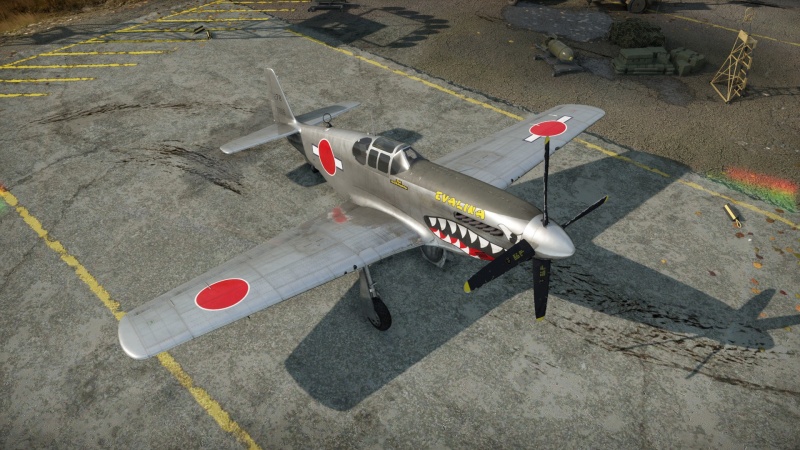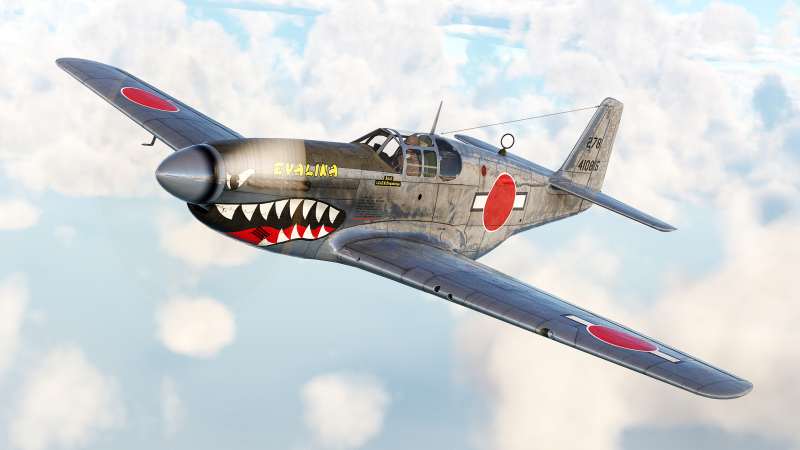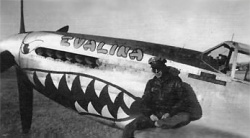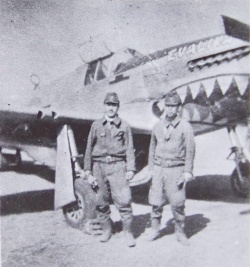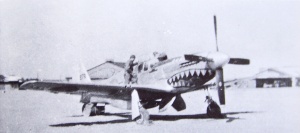P-51C-11-NT (Japan)
| This page is about the Japanese fighter P-51C-11-NT (Japan). For other versions, see P-51 (Family). |
Contents
Description
The ▅P-51C-11-NT, nicknamed "Evalina" after the girlfriend of its pilot: 1st Lt. Oliver E. Strawbridge. Captured by the Japanese after an emergency landing on the 16th of January, 1945, she was left in her original scheme with Hinomarus painted over the American stars before she was sent over back to Japan. There she would be thoroughly evaluated, examined, and used in mock battles by the Japanese Army until just before the end of the war.
Introduced in Update "Red Skies", the P-51C-11-NT is a carbon copy of the American P-51C-10 without any bomb ordnance. Being an early P-51 model, it still gets late war .50 cal belts as a result of being captured in 1945, offering the very deadly full AP-I/T belts putting any target it faces ablaze. The P-51 will be a whole different plane to the average Japanese pilot and they will have to adjust to its American playstyle, flying fast and hitting hard with plenty of ammo, before disengaging and regaining altitude.
General info
Flight performance
Unlike its Rank II predecessors, the P-51 and A-36, this plane performs well not only at low altitudes but also above 3,000 metres because of the new Merlin engine and two-stage supercharger instead of one-stage in the Allison powered models. Level speed is exceptionally good at all altitudes compared to the opposition at similar battle ratings. In Realistic Battles, it can reach 610 km/h at sea level and 705 km/h at 7,300 metres of altitude. Acceleration is also above average in level flight. The climb rate is good, especially when compared to the other American planes, and is noticeably better than the P-51D-5 and P-51D-20. At low altitude, it is slightly above 20 m/s and the plane can reach 6,000 m alt in about 7 minutes. Diving performance is great as usual, its elevator and other control surfaces do not lock up even at 700-800 km/h IAS and can pull 9G at that speed. Medium and high-speed manoeuvrability is good enough to keep up with the Bf 109 G and similar fighters for a while, and the sustained turn rate has been improved over previous Mustangs. Horizontal energy retention is very good, vertical energy retention is good, but manoeuvring energy retention is somewhat below average (but only in RB because of how the instructor controls the plane). Low speed manoeuvrability is still mediocre. The main issue is its rudder, which can lock up above 300 km/h IAS, albeit not to the extent of the P-51D models since the "razorback" fuselage provides better directional stability. The roll rate is not exceptional, veering into poor territory at low speeds.
If using Manual Engine Controls, it is worth mentioning that the Meredith effect is modelled on Mustangs. The cooling system is designed to generate a slight thrust that partially compensates for the aerodynamic drag caused by the radiators. This means that opening up the radiators even to high percentages only causes small effects on energy retention and top speed while keeping the engine nice and cool on WEP settings.
When flying with full realistic controls, the plane requires some trimming, positive for the elevator (+ 5-7) and rudder or ailerons to the right (but only below 600 km/h IAS) if you want to keep the plane straight in the level flight, when turning the plane tends to roll to the right side. Stall characteristics are very good, with the fuel set to 30 minutes it stalls out only when the elevator deflection reaches 90%. It does have a high stalling speed, however, at 175 km/h without flaps and 155 km/h with flaps.
| Characteristics | Max Speed (km/h at 7,300 m) |
Max altitude (metres) |
Turn time (seconds) |
Rate of climb (metres/second) |
Take-off run (metres) | |||
|---|---|---|---|---|---|---|---|---|
| AB | RB | AB | RB | AB | RB | |||
| Stock | 685 | 666 | 22.0 | 22.6 | 12.9 | 12.9 | 300 | |
| Upgraded | 734 | 708 | 20.5 | 21.0 | 20.2 | 16.2 | ||
Details
| Features | ||||
|---|---|---|---|---|
| Combat flaps | Take-off flaps | Landing flaps | Air brakes | Arrestor gear |
| ✓ | ✓ | ✓ | X | X |
| Limits | ||||||
|---|---|---|---|---|---|---|
| Wings (km/h) | Gear (km/h) | Flaps (km/h) | Max Static G | |||
| Combat | Take-off | Landing | + | - | ||
| 676 | 676 | 433 | ~11 | ~5 | ||
| Optimal velocities (km/h) | |||
|---|---|---|---|
| Ailerons | Rudder | Elevators | Radiator |
| < 500 | < 300 | < 550 | > 400 |
Survivability and armour
The survivability is similar to most other prop fighters. The engine is located in the nose, and the fuel tanks are located behind the pilot's seat and in the wing roots. There is significant armour protection for the pilot, but the pilot is still vulnerable from the top, bottom, and sides. The fuel tanks are also vulnerable, as is the cooling system.
- 38 mm Bulletproof glass - Windshield
- 11.11 mm Steel - Behind pilot's seat
- 6.35 mm Steel - Behind engine, in front of oil cooling system and pilot
- 6.35 mm Steel - In front of upper engine
- Self-sealing fuel tanks
Modifications and economy
Armaments
Offensive armament
The P-51C-11-NT (Japan) is armed with:
- 4 x 12.7 mm M2 Browning machine guns, wing-mounted (280 rpg outer + 350 rpg inner = 1,260 total)
While the Evalina only has 4 x 12.7 mm MGs, she does get late-war belts for ammo choice, giving her relatively more consistency and firepower over the American P-51C-10 with early war belts.
Since the guns are mounted in the wings, gun convergence should be considered. Anywhere between 400-600 metres should work well, but note that more distant convergence settings will make close-range shooting more difficult, especially considering the low volume of fire.
Usage in battles
The P-51C-11 has outstanding performance compared to other planes that can meet in the same bracket (Enduring Confrontation 3, BR 3.7-4.7), level speed is higher at all altitudes than anything that it can face, so it can easily escape from anything when it finds itself in a trouble, climb rate is also very good and allows it to quickly get to the 3,000-5,000 m alt. This plane like all other Mustangs does not overheat when the radiator is set to 90-100%, it also does not slow down the plane, so it can always cruise with enabled WEP which is not limited, always engage other planes with humongous speed advantage and make use of very good mid and high-speed manoeuvrability. Sustained climb rate is worse than that of the Bf 109 F-4 or G-2 by 2-4 m/s, escaping from them by climbing away should be avoided, but still allows the plane to get pretty quick to 3,000-5,000 m alt, also the zoom climb is very good.
One issue that the plane has is quite disappointing armament, sometimes it takes some time to shoot down the enemy fighters and it is even worse against bombers and attackers with higher durability, but attacking with a speed advantage and surprising the enemy should solve it.
The other issue is unsatisfactory turn rate at low speed, engaging other fighters in dogfight should be avoided (instantaneous turn rate is actually good when the plane has lots of energy to spare), especially the Bf 109 F-4, G.55 or Yaks and anything that can turn better than them, the speed advantage should be used instead to beat them.
Because of these points, the preferable tactics for this plane should be Boom and Zoom and other manoeuvres that do not purely depend on turn rate and more on the plane's speed. Dogfighting can work to some extent and against some planes like the Fw 190 A (which does not really stand a chance against the razorback Mustang) but while doing that the player will be forced to sacrifice speed advantage and make the plane vulnerable to attacks from slower planes with far better turn rates.
Manual Engine Control
| MEC elements | ||||||
|---|---|---|---|---|---|---|
| Mixer | Pitch | Radiator | Supercharger | Turbocharger | ||
| Oil | Water | Type | ||||
| Not controllable | Controllable Not auto controlled |
Controllable Auto control available |
Controllable Auto control available |
Separate | Not controllable 2 gears |
Not controllable |
Pros and cons
Pros:
- Outstanding Boom & Zoom capability
- Great performance at altitude
- Very fast at all altitudes, especially in a shallow dive
- Very agile at high speeds due to laminar flow wings
- Decent cockpit visibility
- Large fuel capacity (1 hour 45 minutes maximum flight time)
- Fantastic top speed and acceleration
- Very good sustained climb rate
Cons:
- High stall speed and mediocre low speed manoeuvrability
- No suspended ordnance
- Not very durable
- Roll rate, while not terrible, is not sufficient enough to shake enemy planes off or force overshoots
History
Introduction
Starting early 1943, the Japanese had a new foe to fight in the skies, the P-51 Mustang. While Japan saw early successes, it still would prove that the P-51 is a very dangerous foe. The threat would become worse with the introduction of the Merlin-engined P-51B/C and P-51D.
As Japanese casualties started counting up because of this monster of a plane, it became a more pressing issue to get the plane evaluated and look for any flaws in its designs to even out the odds.
While Japan had some models to examine, they were all damaged beyond repair and/or were burnt-out wrecks. But this lack of research material would change eventually.
P-51C-11-NT "Evalina"
Japanese Capture
Built in Dallas, Texas, as c/n 111-28949, registered 44-10816 was allocated to First Lt. Oliver E. Strawbridge of the 26th FS, 51st FG, 14th AF, who named the aircraft "Evalina" after his at the time girlfriend.
One day the plane was commandeered by Second Lt. Sam McMillan, Evalina was hit by Japanese flak fire and an emergency landing was made in a ricefield near the Japanese-held Suchin airfield in the Hubei Province, China on 16 January 1945.
Sam was taken as a POW and would be part of the POW group known as "The Diddled Dozen" that were separated from all other prisoners and taken back to the Japanese homeland.[1][2]
The Japanese on the other hand would finally have a Mustang given on a golden platter. Any damage to the aircraft was quickly repaired, painted Hinomarus over the American stars and left the rest of Evalina in her original scheme.
| While sources are scarce, the plane was in good condition on Japanese images, and if a belly landing happened, it would break the propeller and damage the belly intake; making it barely repairable for the Japanese. |
Japanese Evaluation
Once the Japanese got their hands on the Evalina, she would be sent as soon as possible back to Japan at the Japanese Army Air Inspection Center in Fussa (now Yokota Air Base) piloted by air ace Major Yasuhiko Kuroe.
Upon arrival, Kuroe would evaluate and comment on the Mustang in Fussa, stating:
|
I was astonished with its performance. Turn characteristics were splendid, almost the same as the Ki-84 in a horizontal turn. The radio transmitter was excellent, the armament and other miscellaneous equipment was very good, particularly when compared with their Japanese equivalents, and moreover it had a radio direction-finder. Its dash speed was inferior to that of our imported Fw 190 A-5, but diving speed and stability during the dive were excellent. After fuel consumption tests we estimated it would be able to fly over the Japanese homeland from Iwo Jima. Some time later this came true. |
After its initial evaluations at the Air Inspection Center, Evalina was sent to the Akeno Army Flying School for further evaluation and mock combat against Japanese fighters such as the Ki-43, Ki-61 and Ki-84.
In mid-April 1945, Maj. Kuroe was placed in charge of a "flying circus". The group toured Japanese fighter units to train pilots how to fight the opponent's aircraft.
One of the pilots who benefited from this was a 1st Lieutenant from the 18th Sentai, Masatsugu Sumita, who recalled that he learned "how to take his aircraft out of the P-51's axis when being chased...".
At the time, the 18th Sentai was issued with the new Ki-100, one of the few Japanese planes that matched the Mustang's general performances, albeit with inferior equipment. Kuroe claimed:
|
I had such confidence with this P-51 that I feared no Japanese fighters. |
The Japanese impression of the Mustang was that it was an excellent all-around aircraft with no major fault and excellent equipment. The absence of oil leaks was surprising to most, as all Japanese engines leaked to some extent. Several pilots were invited to fly the fighter. Among them was Yohei Hinoki, one of the first to shoot down a Mustang in November 1943:
|
Major General Imagawa asked me to master the P-51 and then demonstrate it to other fellow pilots. I did not have a great deal of confidence in my ability to fly such an advanced aircraft with my disabled leg, but I made up my mind to do my best. I flew to Omasa airfield and finally got a look at the P-51. I could see the superiority of its equipment, and its shiny fuselage with the open red mouth of a dragon. I saw several red dots on the side of the cockpit, probably recording Japanese aircraft the pilot had shot down. With the radiator under the fuselage, it looked very sleek and deadly. It reminded me of the day I had first seen the P-51 in the sky above Burma on 25 November 1943. Major Kuroe, who brought the P-51 back from China, told me how easy the P-51 was to fly. Getting in, I was very impressed by the roomy seat and I did not have any trouble with my artificial leg on the rudder pedal. For me there were several new things about the aircraft. First of all there was the bulletproof glass, with a better degree of transparency than the thin Japanese glass; secondly, the seat was surrounded by a thick steel plate which I had never seen in a fighter before; there was an automatic shutter for the radiator, and an oxygen system which was new to me. Overall, it was better equipped than any Japanese airplane I had ever seen. |
After all of the intensive evaluations, mock-fights and transfers, Evalina finally gave in and her generator burnt out. As Japan at this state in the war had way more pressing issues and couldn't find any replacement parts, she would be bulldozed into a lake to never be seen again.
Although the Evalina would be the only P-51C the Japanese got their hands on, there are accounts of where the Japanese got their hands on at least 3 P-51Ds with even scarcer information as they were captured barely weeks before the end of the war.
Aftermath
Both Oliver E. Strawbridge and Sam McMillan survived the war and lived to old age. However, Strawbridge never ended up marrying Evalina.
Yasuhiko Kuroe
Yasuhiko Kuroe ended up being officially credited with 30 destroyed aircraft, 3 of which were B-29s, he played a vital role in evaluating and testing the Ki-102, Ki-106, Ki-109 and Ki-200 all intended to shoot down B-29s.
After the war, he returned to his hometown and picked up on agriculture as all of Japan's military would be dismantled. While starting a new life as a farmer, he ended up running on food shortage and got into some shady business and poor life choices and got into debt.
He moved to Tokyo and managed to join the JASDF (Japanese Air Self Defense Force). As an experienced pilot in both propeller- and jet-driven planes he got back into the Air Force and returned to his balanced life. He was sent abroad to study in the Royal Air Force in Britain for a year and returned to Japan eventually climbing up to the rank of Major General.
One day in 1965 Maj.Gen. Kuroe went fishing off the Echizen coast, Fukui Prefecture during bad weather and eventually drowned in the high waves. He was buried on December 7 of that year.
Media
- Skins
See also
- Other Japanese-captured US planes
External links
References
| North American Aviation | |
|---|---|
| Fighters | |
| P-51A | P-51 · P-51A |
| P-51C | P-51C-10 |
| P-51D | P-51D-5 · P-51D-10 · P-51D-20-NA · P-51D-30 |
| P-51H | P-51H-5-NA |
| Twin-engine fighters | F-82E |
| Jet fighters | F-86A-5 · F-86F-2 · F-86F-25 · F-86F-35 · F-100D |
| Strike aircraft | A-36 · PBJ-1H · PBJ-1J |
| FJ-4B · FJ-4B VMF-232 | |
| Bombers | B-25J-1 · B-25J-20 |
| Export/Licence | ▂B-25J-30 · ␗B-25J-30 |
| ▄Mustang Mk IA · F-6C-10-NA · ␗P-51C-11-NT · ␗P-51D-20 · J26 David · J26 · P-51D-20-NA · ␗P-51K | |
| F-86F-30 ▅ · ␗F-86F-30 · F-86F-40 ▅ · F-86F-40 JASDF▅ · ␗F-86F-40 | |
| ◄F-86K · ▄F-86K (Italy) · ▄F-86K (France) | |
| ␗F-100A · ▄F-100D · ␗F-100F | |
| Captured | ▅P-51C-11-NT |
| Canadair Limited license-built the F-86 as the CL-13 for use in Canada and export to Europe. | |
| Fiat license-built the F-86K for the Italian Air Force though another 120 NAA built F-86Ks were also sold to the Italians. | |
| See Also | Mitsubishi Heavy Industries · Canadair Limited · Fiat Aviation |
| Japan fighters | |
|---|---|
| Navy | |
| Carrier-based fighter | |
| A5M | A5M4 · Hagiri's A5M4 |
| A6M | A6M2 mod. 11 · A6M2 · A6M3 · A6M3 mod. 22 · A6M3 mod. 22Ko · A6M5 · A6M5 Ko · A6M5 otsu · A6M5 Hei · A6M6c |
| A7He | A7He1* |
| A7M | A7M1 (NK9H) · A7M2 |
| Land-based Fighter | |
| J2M | J2M2 · J2M3 · J2M4 Kai · J2M5 · J2M5 (30 mm) |
| J6K | J6K1 |
| J7W | J7W1 |
| N1K-J | N1K1-Ja · N1K2-J · N1K2-Ja |
| Fighter seaplane | |
| N1K | N1K1 |
| A6M-N | A6M2-N |
| Army | |
| Ki-10 | Ki-10-I · Ki-10-I C · Ki-10-II · Ki-10-II C |
| Ki-27 | Ki-27 otsu · Ki-27 otsu Tachiarai |
| Ki-43 | Ki-43-I · Ki-43-II · Ki-43-III otsu |
| Ki-44 | Ki-44-I · Ki-44-I 34 · Ki-44-II otsu · Ki-44-II hei |
| Ki-61 | Ki-61-I ko · Ki-61-I otsu · Ki-61-I hei · Tada's Ki-61-I hei · Ki-61-I tei · Ki-61-II Otsu Kai |
| Ki-84 | Ki-84 ko · Ki-84 otsu · Ki-84 hei |
| Ki-87 | Ki-87 |
| Ki-94 | Ki-94-II |
| Ki-100 | Ki-100 · Ki-100-II |
| Other countries | ▅F4U-1A · ▅P-51C-11-NT · ▅Bf 109 E-7 · ▅Fw 190 A-5 |
| *Imported designation of the He 112 (A6M was in development - A7M would take A7 designation after the cancelation of the A7He) | |
| Japan premium aircraft | |
|---|---|
| Fighters | Hagiri's A5M4 · A7He1 · Ki-27 otsu Tachiarai |
| Ki-44-II otsu · ▅Bf 109 E-7 · ▅F4U-1A · Ki-100-II · Ki-44-I 34 | |
| ▅Fw 190 A-5 · A7M1 (NK9H) · Tada's Ki-61-I hei · ▅P-51C-11-NT | |
| J2M4 Kai · A6M5 Ko · A6M6c · J2M5 · Ki-87 · J6K1 | |
| Twin-engine fighters | Ki-96 |
| Jet fighters | F-86F-40 JASDF▅ · T-2 Early · F-4EJ ADTW |
| Strike aircraft | ▄AV-8S |
| Bombers | Ki-21-I hei · Ki-48-II otsu · H8K3 · B7A2 (Homare 23) · ▅B-17E |



